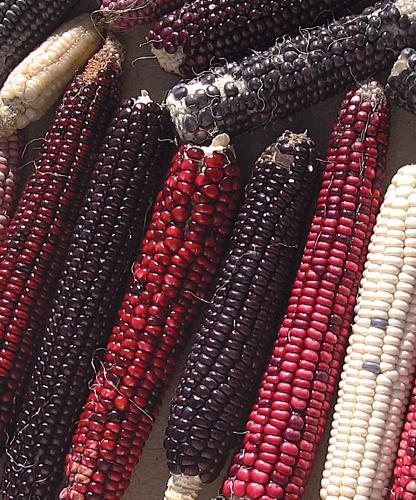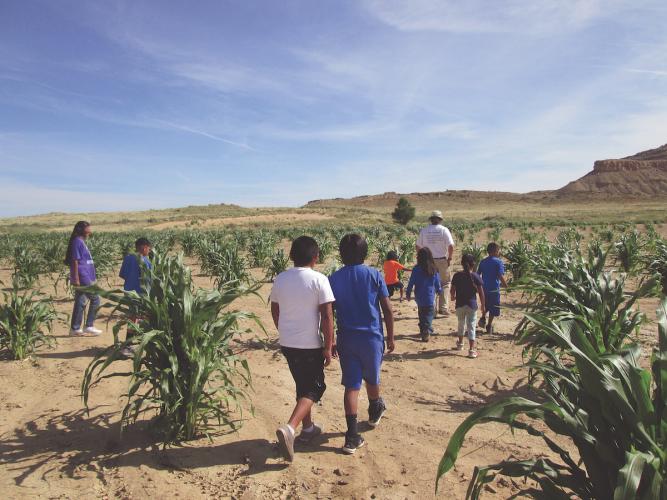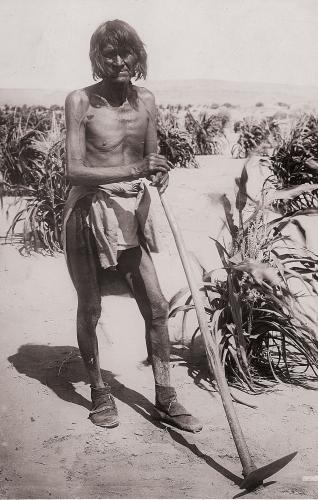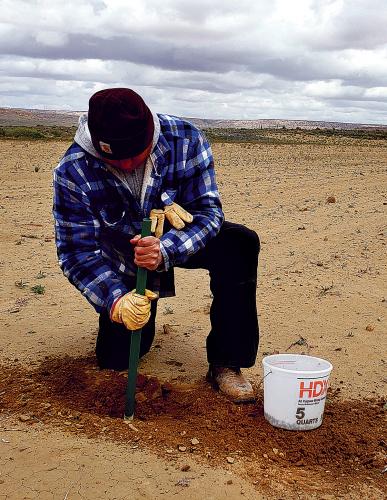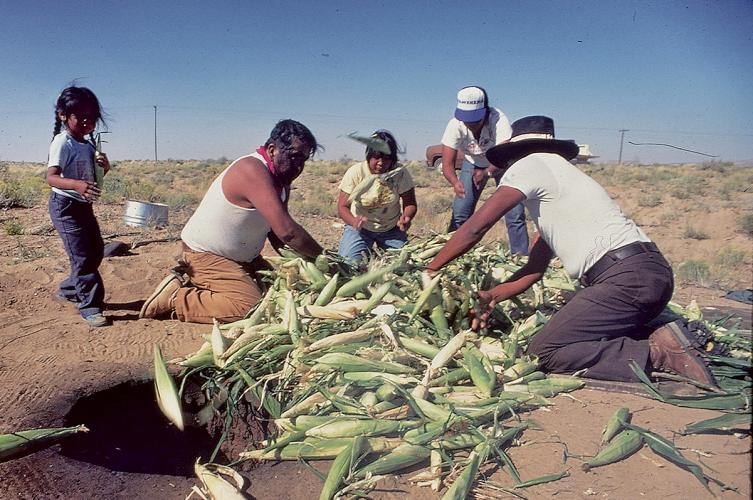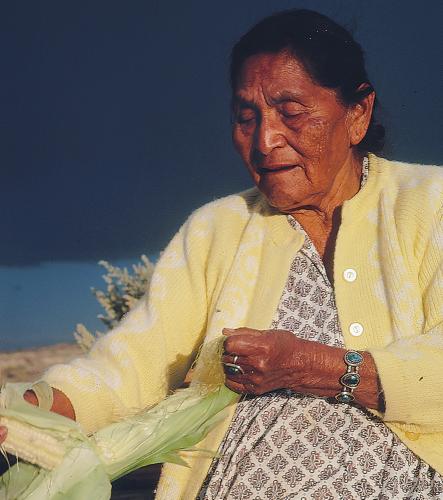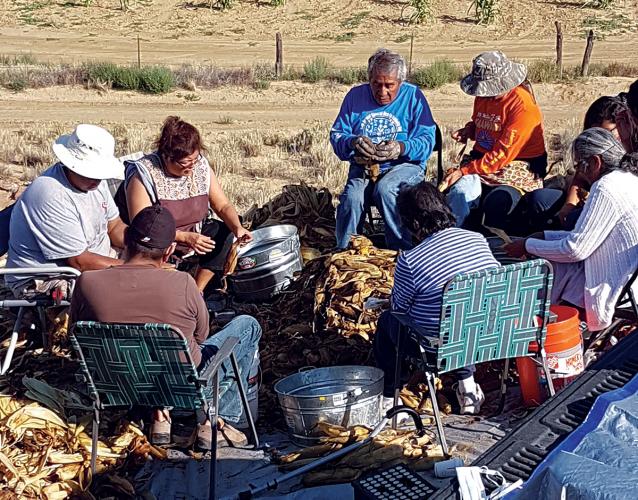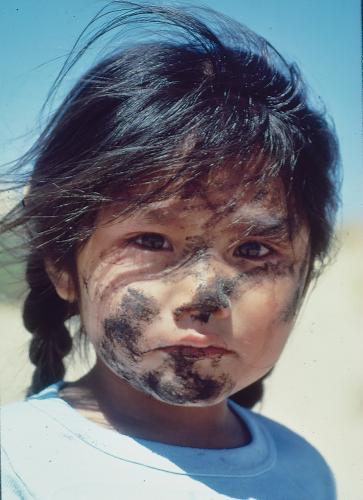As a boy, Stewart B. Koyiyumptewa awoke early on spring days to plant corn, following his grandfather out to Dinnebito Wash, the dry riverbed below their village on the Hopi Reservation in northeast Arizona. Like their ancestors, they tramped up the wash, stopping every few paces to clear off a patch of sandy topsoil with a hoe. Koyiyumptewa walked behind, digging into the moist earth below with a greasewood stick flattened at one end. He dropped a few kernels into each hole and covered them over with earth and sand.
At noon, they paused for a lunch of sandwiches, watermelon and paper-thin “piiki” bread made from blue Hopi corn. Then they returned to the slow, repetitive work of planting and cultivating corn in the dry land. Today, the same scene is repeated each year, for many Hopi families still plant crops the same way their ancestors did 2,000 years ago.
The Center of Hopi Life
Producing an ample corn crop is critical for the Hopi, for the plant provides far more than mere subsistence. All of Hopi life revolves around the corn planted each spring.
The Hopi people’s origin stories say that long ago, the Guardian Spirit, Màasaw, offered the clans several gifts: wood that would become the Hopi planting stick, a bag of corn kernels, a gourd of water and a small ear of blue corn. At Màasaw’s direction, the clans began an extended migration. They learned on the way to cultivate corn and a better life, one that embraced unity, selflessness, cooperation, harmony with nature and stewardship of the land.
Perhaps reflecting those early wanderings, the many colors bred into Hopi corn are still associated with directions across the landscape; yellow suggests northward; white, eastward; red, southward; and blue, westward; whereas purple signifies above and sweet corn, below.
Corn is present at every stage of life, every ceremony, every key moment in the cycle of the seasons, says Koyiyumptewa, now the program manager at the Hopi Culture Preservation Office in Kykotsmovi Village, Arizona. “Corn is the first thing they feed you when you’re born, and cornmeal sends you off to the spiritual world when you pass on.”
Hopi women have the authority to make many of the decisions about their community’s agriculture because Hopi clans are matrilineal. Husbands and unmarried sons grow corn for the clan of their wives and mothers. When a man marries, he moves to live with his wife’s clan and grows corn for its members.
In late winter, Hopi women look over their stocks of corn and consider what colors and quantities must be planted for the coming year. How much is needed for food? How much for festivities, ceremonies and prayers? Through their calculations, they direct the men what to plant. Before planting, the women prepare and bless the seeds to encourage a good harvest.
Armed with the women’s knowledge and the seeds to plant that year, the men venture into the fields. Depending on their assessment of soil moisture and the chances of frost, planting may start as early as April, but most corn goes into the ground in late May and early June. Yet uncertainty remains: A late spring frost can kill a whole crop, and an early fall frost reduces yield.
Farming with Dry Land
Corn was first domesticated about 9,000 years ago in the lowland tropics of Mexico. It was introduced to the region that is now the southwestern United States about 4,000 years ago, but it took another 2,000 years of close observation and careful selection by farmers for the corn to adapt to the area’s higher, drier elevations and shorter growing season. In the process, the Hopi people became masters of dry-land farming.
Hopi villages are located at the southwest ends of three highlands—called the First, Second and Third Mesas—that run down from the Colorado Plateau in northeastern Arizona. The mesas are separated by seasonal riverbeds called washes. The favored planting location is an “ak-chin” field, an area on the alluvial fan where the water spreads out at the mouth of the wash. Hopi can identify the soil’s capacity for moisture below by the kind and quantity of natural vegetation growing on the surface.
“The weeds will tell,” says Michael Kotutwa Johnson (Hopi). For instance, land adjacent to fields dominated by rabbitbrush indicates abundant soil moisture. Johnson and University of Arizona educator Lisa Falk co-curated an exhibition about “The Resiliency of Hopi Agriculture” that is on display at the Arizona State Museum—a Smithsonian Affiliate— through January 2020.
The Hopi farmers also grow beans, squash, melons and some fruit trees. Some of those fields may be irrigated, but the Hopi never irrigate their corn. That crop depends solely on two sources of water: winter snowfall and summer rain. Only the moisture stored in the soil is available from planting time until midsummer, when rains usually fall. The Hopi hedge their bets by planting corn in multiple fields in dissimilar locations up and down the wash or in side canyons. Planting at separate sites increases the chances that at least one will produce a good crop.
Once they decide where to plant, the Hopi men clear off any weeds and scrape away a small patch of the sandy surface layer of the soil. The sand serves as kind of mulch, preventing moisture in the loam below from evaporating too rapidly. The planters plunge the flat-tipped digging stick into the ground, creating a hole a foot deep, then plant eight to 12 kernels in each hole so the corn grows in clumps. Each clump is five to seven paces away from its neighbor to ensure that enough water is available for optimum growth. Depth and spacing can depend on soil moisture at planting time, the field’s location relative to rainwater runoff and whether it is composed of clay or loam, among other factors.
“Enormous amounts of traditional ecological knowledge are associated with dry farming,” says Susan Sekaquaptewa, a Hopi tribal member who works for the University of Arizona’s Cooperative Extension Program. “The environment dictates the technique, and you only learn that from experience.”
Conventional corn is planted only 2 inches deep and 6 to 8 inches apart. The Hopi plant their corn deeper to catch the moisture from the winter’s melted snow, which lies farther below the surface. That required careful selection of plants, preserving changes that became encoded in their genes. When Hopi corn germinates, the seed sends out a single strong root downward, searching for the water that lies even deeper in the ground. It also sends a shoot upward to the surface. These adaptations, which are lacking in conventional varieties, helped Hopi corn thrive in a hot, dry environment for 2,000 years.
“Hopi agriculture is the end result of a complicated process of culture, biology and environment,” says Kelly Swarts, a geneticist and archaeologist at the Gregor Mendel Institute of Molecular Plant Biology at the University of Vienna. “The corn used by the Hopi today was mostly developed by the Hopi on the Hopi mesa in response to novel genetic variations. People took advantage of this variation in ways that made sense to them culturally and which were better adapted to the landscape they lived on.”
Once the new corn pokes up above the surface of the ground, Hopi farmers thin the stalks out, leaving only the tallest five to eight plants in each clump. That favors the genes that get plants established and growing quickly. The extra stalks are placed around the remaining plants to shield them from the wind and preserve soil moisture. The farmers do not use fertilizer or insecticides but rather patrol the fields during the summer to pick off cutworms that can damage the plants.
“Hopi is the only place I know where corn is planted to fit the environment,” says Johnson. “The environment is not manipulated to fit the corn.”
Most corn is ready at the young, milky stage by September, says Sekaquaptewa. Some is harvested then and eaten fresh, but it is only available for several weeks. Sweet corn gets special treatment, however. The Hopi men harvest most of it then and take it to a stonelined, bell-shaped pit where a fire has burned all day. They place the corn, still in the husk, in the pit, which cooks it, steaming overnight. The next morning before sunrise, the men remove the corn from the pit. The Hopi women then step in and prepare it for drying. They first clean off the husks and string the ears through the stem and hang them up to dry. When the ears are dry, the women can use this preserved corn in many ways. They can cut off the kernels and grind them into a corn meal of surprising sweetness. Alternatively, kernels can be shelled and added to stews. Boiling the whole dried ears later brings back their freshness so they can be eaten like newly harvested sweet corn. Some of the rest of the corn is left to mature and added to the seed stock for future years.
Later in the autumn, the Hopi men harvest the rest of the corn. They bring it home to their wives or mothers, who will once again carefully dry and store them. A select, few perfect ears are saved for ceremonial use. As the corn is picked, the farmers press the empty stalks into the ground to “put them to sleep,” says Sekaquaptewa. The roots stay in the ground to loosen and replenish the soil. The next year, clumps will be planted a few steps away so as not to exhaust the soil.
This planting cycle continues every year, as it has for a hundred generations. “Dry land farming is not about growing food; it is a religious practice,” says Sekaquaptewa. “It teaches us modesty and humility, to live in harmony with and respect the land and all that it gives to us. Farming is an inspiration for song. Life in the fields is poetry.”
Bending Not to Break
The annual rhythm of the corn has lasted two millennia. The Hopi have always adapted to change, but they live in a new era, one that brings new challenges to their way of life.
“As more people get involved in the modern working system and a cash economy, there is often not enough time to attend to farming,” says Sekaquaptewa. “It’s hard to combine the old and new ways at the same time, and it’s affecting how the culture gets transmitted.”
Many Hopi work hard to carry on the traditional planting, though. Michael Kotutwa Johnson is among those who take Hopi children out to the fields and talk to them about seeds and water and sun and their people’s deep-rooted tradition of farming corn. “Growing corn is how we learn about patience, responsibility, working together and the spiritual aspects of our ceremonies,” he says.
Stewart Koyiyumptewa also still plants part of his field by hand just so his 17-year-old son will understand his people’s traditional techniques and pass them on. Koyiyumptewa clears the rest of his land with a tractor equipped with a mechanical device that drops the kernels into the ground.
Meanwhile, a changing climate has made the Hopi lands hotter and drier, with less snowfall, later spring snows that can kill early plantings, and earlier autumn frosts that shorten the growing season. “Less snowfall means less soil moisture, and so the time from May to June before rain falls becomes more critical,” says Koyiyumptewa. “The rain comes late and often too little of it. The corn is stunted and the yield lower. With less rainfall, plowing causes the dry top layer of soil to blow away.”
The changing climate brings another concern. Over centuries, Hopi people have grown corn varieties that thrive better in their hot, dry environment. Today, corn breeders are interested in those qualities.
Many Hopi are concerned about the future of their beloved crop. They don’t want to see its genetic heritage disrupted, deliberately or accidentally, by crossbreeding with modern varieties. “Our corn has been adapted to this area for a long time and we need help to protect our seeds,” says Koyiyumptewa.
He also worries that large agribusiness conglomerates will exploit the genes in Hopi corn and patent the results, earning profits that would not be shared with the tribe. Thus far, that has not happened, and it is not easy to breed specific traits into commercial varieties. The U.S. Department of Agriculture corn gene bank in Ames, Iowa, has 59 samples of Hopi corn contributed from the 1950s through the 1970s, but it is unknown whether anyone has accessed them.
Leigh Kuwanwisiwma, former head of the Hopi Culture Preservation Office, would like to see the Hopi establish a seed bank on the reservation to safeguard their heritage. The seeds would be grown out every few years, but in traditional ways so the corn doesn’t lose the extraordinary genetic traits accumulated over more than 2,000 years. Such a plan would preserve not just the corn but also the Indigenous knowledge that surrounds it.
“We see corn as the gift of the spirit being that rules this world as the caretaker of corn,” says Kuwanwisiwma. “He gave us corn to be our soul. Hopi corn survives because our religion is still strong and our values are important to us.”

